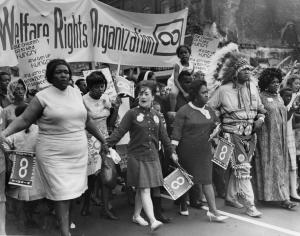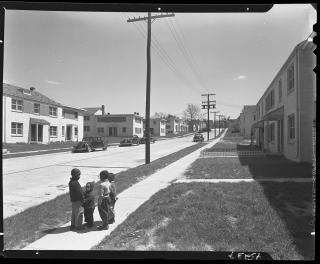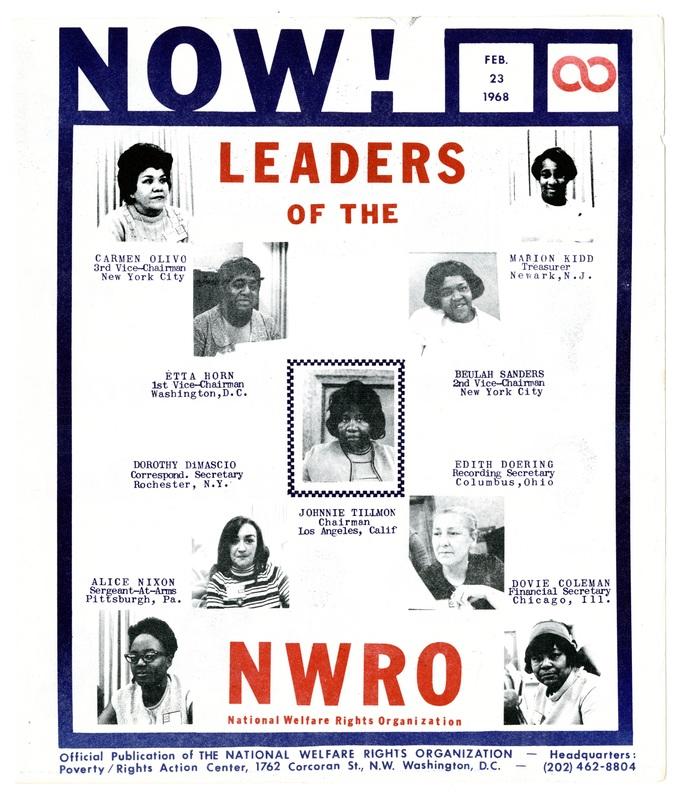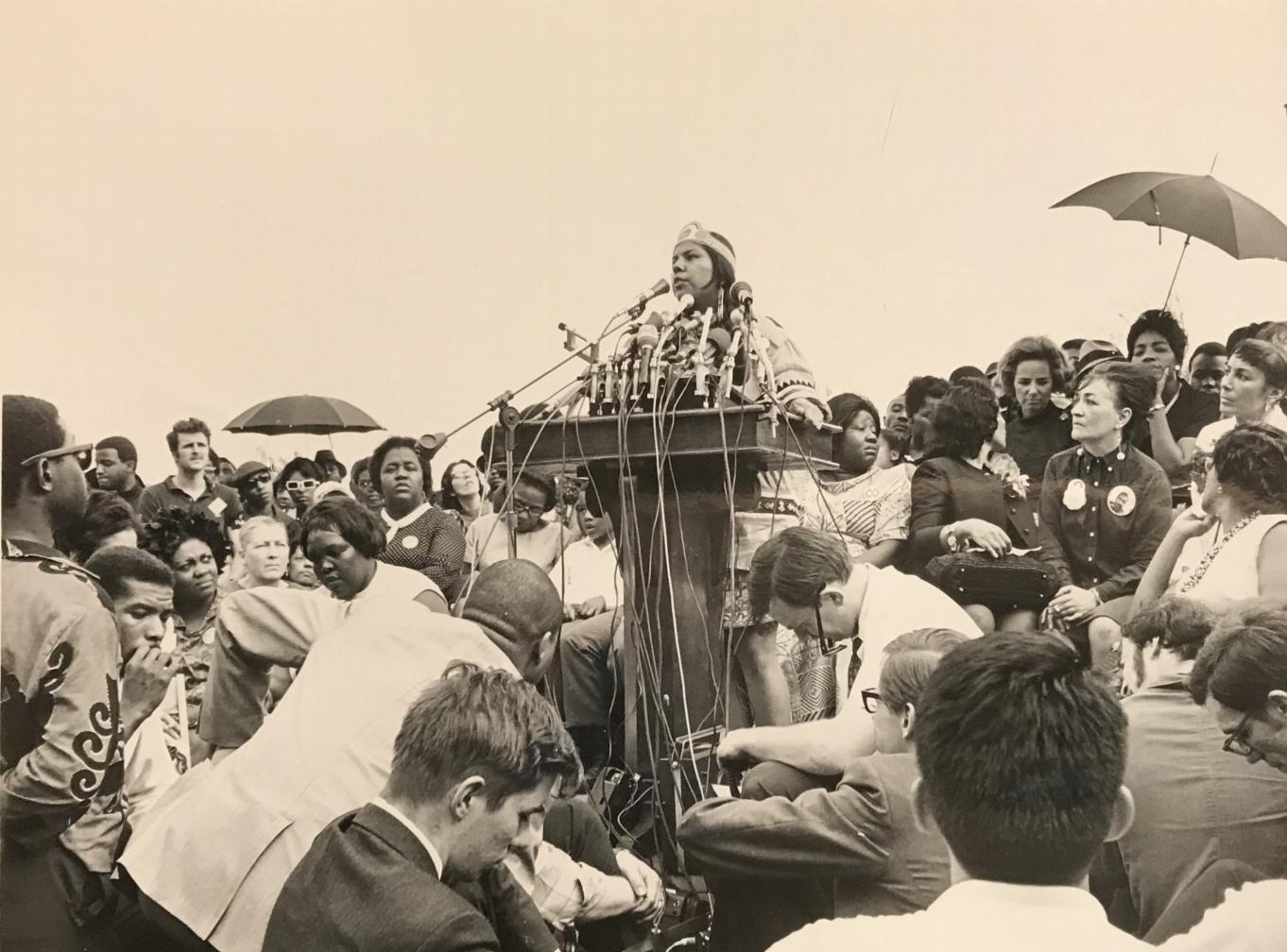Etta Horn

Etta Horn was a prominent welfare rights advocate. As an activist, she worked alongside other anti-poverty organizers to improve the living conditions of low-income DC residents. Though she had many successes, Horn is widely celebrated for her work with the Citywide Welfare Alliance.
Etta Mae Horn was born in 1928 in Charlotte, North Carolina. Beyond knowledge of her birth year, scholarship regarding Horn’s early life beyond her anti-poverty pursuits is lacking*. She made her way into the welfare rights scene in the late 1960s. At the time of her involvement, she lived in Barry Farms Dwellings with six of her seven children. Located in Anacostia, a historic southeast DC neighborhood, Barry Farms Dwellings was a segregated apartment complex. Founded in 1865, the 375-acre plot was dedicated to “[supporting] Black land ownership in the wake of the Civil War,” (Shoenfeld 2020, DC Historic Preservation Office). Then called “Potomac City,” it was also interchangeably known as “Barry Farm,” “Barry’s Farm,” (after original land owner James Barry), and, following a final name change in 1873, “Hillsdale” (DC Historic Preservation Office). Many Black Americans lived on this land, but the Barry Farms Dwellings complex Horn would come to live in was not built until 1942.

Between 1942 and the early 1960s, the quality of the homes had decreased significantly due to government neglect. Poor maintenance left the condition of the buildings well below a livable standard. As such, there were ample reports that “rats and cockroaches ran rampant, faucets leaked, and one resident's ceiling had crashed onto her stove” (DC Historic Preservation Office). Given the opportunity to both see and experience these circumstances as a resident herself, Horn became fully committed to pursuing better conditions for Barry Farms residents.
In 1966,Horn and another tenant, Lillian Wright, formed the Barry Farms Band of Angels . The woman used federal dollars allocated to support organizing in low-income neighborhoods, the result of President Lyndon B. Johnson’s War on Poverty, to help form the Band of Angels. Due receiving assistance, DC’s United Planning Organization granted funds and the assistance of trained organizers to Southeast neighborhoods such as Anacostia (DC Historic Preservation Office). As a result, improvements to the complex by the National Capital Housing Authority (NCHA) were soon to come. Convinced tenant needs would still not be met, the Band of Angels thoroughly vocalized the everyday woes they experienced living in the faulty complexes to the NCHA.
The Angels recognized that simply describing the complex’s poor conditions was not enough. NCHA director, Walter Washington, would need to see the pest problem and faulty plumbing (amongst various other issues) firsthand (Valk 2010). Threats of protesting outside NCHA offices prompted Washington’s visit to Barry Farms. Upon seeing the state of the buildings, the Band of Angels successfully acquired 1.5 million dollars from the NCHA to make the necessary repairs (DC Historic Preservation Office). Repairs made to improve quality of life included eliminating pests, hazards presented by poorly maintained streets, and defective plumbing. A combination of efforts elevated the success of Barry Farms residents, which resulted in “...[an increase of ] funds for fixing up Barry Farms…and essential needs, recreation programs…, daycare and job counseling…, and a black police captain…assigned to the local precinct” (DC Historic Preservation Office). In the wake of this success and no stranger to organizing, Horn became the head of the antipoverty group, Citywide Welfare Alliance (CWA).
In its earliest iteration, the CWA was once the Washington Welfare Alliance (WWA). WWA sought “more money, more dignity, and more justice,” (Valk 2010, p. 40). Formed by Horn as well as various other women in D.C., all involved had one prominent detail in common: they each received Aid to Families With Dependent Children (AFDC). As described by the Office of The Assistant Secretary for Planning and Evaluation, AFDC “...was established by the Social Security Act of 1935 as a grant program to enable states to provide cash welfare payments for needy children who had been deprived of parental support or care because their father or mother was absent from the home, incapacitated, deceased, or unemployed,” (ASPE). Though these payments sought to alleviate financial hardship —particularly concerning poor living conditions — this was not the case for many. Welfare did not provide enough assistance to cover the cost of low-income designated housing.
Harrowing conditions such as those experienced by residents in Barry Farms Dwellings were prevalent in other complexes throughout DC. Limited budgets often meant living in “crowded…dilapidated apartments without adequate food, clothing, …household goods, ...air conditioning, automobiles, and telephones,” (Valk 2010, p. 40). The WWA remained dedicated to alleviating poor living conditions; even so, they recognized that a variety of complex and nuanced issues were at the root of these conflicts. Most prominently, the disproportionate number of Black DC residents on welfare in comparison to white residents concerned alliance members.
Along with confronting the racial divide experienced by welfare recipients, the alliance examined how these issues specifically impacted women. They identified two major conflicts: a lack of affordable childcare options and women recipients of AFDC being encouraged to use contraception or to undergo sterilization en masse (Valk 2010). The WWA argued the welfare system was the source of the struggles faced by women fighting for reproductive rights. Horn did not mince words, declaring that the lack of quality care afforded to poor women aimed to kill them and, if not that, keep them from reproducing entirely.
The WWA eventually partnered with the National Welfare Rights Organization (NWRO) to combat an array of socio-political issues. Founded in 1967, the NWRO engaged welfare recipients of all races due to a specific focus on interracial collaboration. The organization was wildly successful, eventually boasting 20,000 members by the late 1960s -- most of them Black women. The NWRO employed many techniques such as “legal action, lobbying, and boycotts,” and has become regarded as a Black feminist force nationally (Social Welfare History Project). Given the prominence of the NWRO throughout the city, WWA officially took on the moniker Citywide Welfare Alliance (CWA) following their partnership. The change reflected CWA’s geographic expansion as they had now grown to include diverse groups throughout DC.

The NWRO was not the only group made up of primarily Black women. Black women made up most DC welfare groups, with Etta Horn herself heavily involved with both the CWA and the NWRO. Her involvement extended far and wide: “[Horn] became vice chairman [of the NWRO] in 1967, between 1967 and 1970, she sat on the National Coordinating Council that directed the NWRO and chaired a committee that coordinated a campaign to win individual recipients credit at major department stores” (Valk 2010, p. 42). During her time as vice chair, Horn also testified before Congressional subcommittees. She protested governmental threats to public assistance and condemned the practice of surveilling welfare recipients (DC Historic Preservation Office). Horn was clear in her demands, once even pointedly confronting elected officials by stating, “you sit up here on the Hill and talk about building subways and bridges and parking lots for tourists and people from suburbia…It’s time to talk about the people who live here” (Anacostia Community Museum).
In May1968, Horn assisted in leading a Mother's Day March in support of welfare rights. 6,000 supporters attended, with figures such as Coretta Scott King in the crowd. Scott King spoke at the event, “[demanding] jobs, a guaranteed income and repeal of the 1967 amendment to the Social Security Act freezing federal welfare funds” (Mcquirter 2020). Horn agreed wholeheartedly with the importance of all of Scott King’s demands. The Mother’s Day March, just one month after Dr. Martin Luther King’s assassination, was one of the first public demonstrations of the Poor People’s Campaign. Horn met with Dr. King earlier that year to discuss the campaign. It was on March 31, 1968, in DC that he publicly declared that the Poor People’s Campaign (a movement meant to unite poor communities across the country) would “establish that the real issue is not violence or nonviolence but poverty and neglect,” (Poor People’s Campaign, Shoenfeld 2020).

Horn would eventually leave the NWRO due to opposition to her leadership. Many members took issue with her leadership style, including NWRO director George Wiley. Described as “flamboyant” and prone to “spontaneous outbursts” by naysayers, Horn asserted that her outspoken nature was simply in support of the cause (Heck 1970). She emphasized that it was rare that she was genuinely angry and that her impassioned nature was strategic rather than indicative of a “lack of sophistication” (Heck 1970). To further make it clear that her passion drove her dedication to welfare rights, Horn stated she believed that there is no such thing as “working for your rights; you fight for them,” and she then went on to say “I have never seen our organization as peaceful. You just can’t be peaceful. Peace means you go in, you go on your knees, you stay on your knees” (Heck 1970). Though no longer involved with the NWRO, she remained a central part of the welfare rights movement.
Most notably, Horn’s work with the CWA continued. She found solace in working with other Citywide members and emphasized that her colleagues often restored her faith in just, non-corrupt organizations. In later years, Horn took on the role of Director of the DC Child Development Center, a position she held for 25 years. She passed away at age 72 in 2001 in Washington, DC (Ancestry). As for her legacy, as of 2020 Barry Farms Dwellings (now called Barry Farm-Hillsdale) has been designated a commemorative site. Though only five buildings are considered part of the historic landmark, Horn’s previous unit is one of the many included within the designation (Shoenfeld 2020). By visiting the site, visitors can fully contextualize Horn’s impact, passion, and unwavering spirit.
* If you have or someone you know has additional details regarding Etta Horn’s early life, NWHM encourages you to reach out to us! Please direct all information to [email protected].
Image Descriptions & Media Questions :
Photo 1: Young residents of Barry Farms Dwellings stand outside of their building shortly after they had been built in 1942.
-
What was the significance of affordable housing being built dedicated solely to Black communities in DC?
Photo 2: A poster of NWRO’s leaders from February 23rd, 1968. Etta Horn is pictured second from the left.
-
Why do you think that a commitment to interracial unity was a prominent pillar of the NWRO?
Photo 3: An unidentified speaker takes the podium at the Mother’s Day March organized by Etta Horn and other members of the NWRO. Horn is to the left of the podium in a bright collar and polka dot dress.
-
What emotions do you recognize of the faces of the listeners in the crowd?
-
What do you think is the significance of a welfare rights march held on Mother’s Day? In what ways are motherhood and welfare rights connected?
- “About.” Poor People’s Campaign. n.d. https://www.poorpeoplescampaign.org/about/.
- Aid to families with dependent children (AFDC) and Temporary Assistance for Needy Families (TANF) - overview. ASPE. (n.d.). https://aspe.hhs.gov/aid-families-dependent-children-afdc-temporary-assistance-needy-families-tanf-overview.
- Ancestry.com. Web: Obituary Daily Times Index, 1995-2016 [database on-line]. Provo, UT, USA: Ancestry.com Operations, Inc., 2012. https://www.ancestry.com/discoveryui-content/view/14808273:70050?_phsrc=vSx1&_phstart=successSource&gsln=Prather&ml_rpos=2&queryId=2b95b1ee4c7ba063f2b01936612f7ac4
- “Community Activism.” Anacostia Community Museum. N.d. https://anacostia.si.edu/barryfarm/people-and-places/community-activism.
- DC Historic Preservation Office, “Civil Rights Tour: Housing - Barry Farm Dwellings,” DC Historic Sites. https://historicsites.dcpreservation.org/items/show/915.
- DC Historic Preservation Office, “Civil Rights Tour: Protest - Poverty Rights Action Center, Welfare Rights,” DC Historic Sites, n.d. https://historicsites.dcpreservation.org/items/show/1023.
- DC Historic Preservation Office. “Barry Farm Dwellings.” ArcGIS StoryMaps, February 4, 2021. https://storymaps.arcgis.com/stories/b56950c5e014461d887ccbf4a950ec04.
- “Etta Horn.” Anacostia Community Museum. n.d. https://anacostia.si.edu/collection/object/acm_2014.0028.0018.
- Heck, Caroline. “Etta Horn and Life: A fiercely independent personality with a certain charm and amiability.” The Washington Post, Times Herald (1959-1973). Sep 6, 1970.
- McQuirter, Marya. “12 May 1968 & 6,000 Join National Welfare Rights Org Mother’s Day March & Rally.” August 12, 2020. https://www.dc1968project.com/blog/2018/5/12/12-may-1968-national-welfare-rights-org-organizes-mothers-day-march-launches-poor-peoples-campaign?rq=etta+horn.
- National Welfare Rights Organization. Social Welfare History Project. 2022, August 29. https://socialwelfare.library.vcu.edu/organizations/national-welfare-rights-organization/
- Shoenfeld, Sarah Jane. “Opinion | Barry Farm’s Historic Landmark Designation Was Pitted against Affordable Housing.” The Washington Post, February 21, 2020. https://www.washingtonpost.com/opinions/local-opinions/barry-farms-historic-landmark-designation-was-pitted-against-affordable-housing/2020/02/20/8af206be-4c26-11ea-9b5c-eac5b16dafaa_story.html.
- Shoenfeld, Sarah Jane. “The History and Evolution of Anacostia’s Barry Farm - D.C. Policy Center.” D.C. Policy Center - Advancing policies for a strong and vibrant economy in the District of Columbia, January 18, 2022. https://www.dcpolicycenter.org/publications/barry-farm-anacostia-history/.
- Valk, Anne M. Radical Sisters: Second-Wave Feminism and Black Liberation in Washington, D.C. Urbana: University of Illinois Press, 2010.
MLA – Dawson, Shay. "Etta Horn." National Women's History Museum. National Women's History Museum, 2023. Date accessed.
Chicago - Dawson, Shay. “Etta Horn." National Women's History Museum. 2023.
Media Citations :
- DCPL Special Collections. Poor People's Campaign Collection. Ken Heinen, photographer
- Gottscho-Schleisner, Inc, photographer. Barry Farms Housing Development, Washington, D.C. Street view II. United States Washington D.C. District of Columbia Washington D.C, 1944. Photograph. https://www.loc.gov/item/2018722792/.
- Jack Rottier photograph collection, Collection #C0003, Special Collections and Archives, George Mason University. https://historicsites.dcpreservation.org/files/show/4268
- Moorland-Spingarn Research Center, Howard University Archives, Howard University, Washington, D.C.
- 1966 Photograph by Paul M. Schmick/Reprinted with permission of the DC Public Library, Star Collection © Washington Post.
- McQuirter, Marya. “17 April 1968 & DC Welfare Alliance Plans Sit-In.” dc1968 project: 365 stories re washington dc in 1968, August 19, 2020. https://www.dc1968project.com/blog/2018/4/17/17-april-1968-dc-welfare-alliance-plans-sit-in.
- “Part of Barry Farm Has Been Named a Historic Landmark.” WAMU, January 25, 2019. https://wamu.org/story/20/01/30/part-of-barry-farm-has-been-named-a-historic-landmark/.





